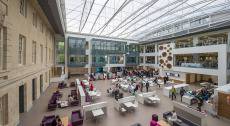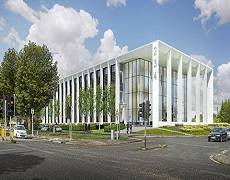October 17, 2014
The solution to complex issues like green building is to become more sophisticated
 One of the current preoccupations of the World Green Building Council is to demonstrate how green business is good business. The way it is presenting this argument is intriguing because as well as extolling the most anticipated benefits of green building design, such as lower energy bills, it is linking green building design with human factors such as productivity, wellness and work-life balance. It has produced a number of reports on this subject, most recently in September with a publication titled Health, Wellbeing and Productivity in Offices which found ‘overwhelming evidence’ of the link between office design and productivity. What such compelling reports also highlight are the complex challenges we face and the sophisticated approach we must take to environmental issues and corporate social responsibility. Fortunately this is already exhibited by many organisations.
One of the current preoccupations of the World Green Building Council is to demonstrate how green business is good business. The way it is presenting this argument is intriguing because as well as extolling the most anticipated benefits of green building design, such as lower energy bills, it is linking green building design with human factors such as productivity, wellness and work-life balance. It has produced a number of reports on this subject, most recently in September with a publication titled Health, Wellbeing and Productivity in Offices which found ‘overwhelming evidence’ of the link between office design and productivity. What such compelling reports also highlight are the complex challenges we face and the sophisticated approach we must take to environmental issues and corporate social responsibility. Fortunately this is already exhibited by many organisations.










 Given the track record of people when it comes to making predictions about the future, it’s easy to grow cynical, especially when it involves a profession as subject to the vagaries of technological and cultural change as facilities management. But while we should be wary of more fanciful and long term thinking, any natural scepticism shouldn’t blind us to those predictions that we know will largely come true, especially those based on what we know is happening already. For example, recent research carried out by Cass Business School and Henley Business School and presented in the book
Given the track record of people when it comes to making predictions about the future, it’s easy to grow cynical, especially when it involves a profession as subject to the vagaries of technological and cultural change as facilities management. But while we should be wary of more fanciful and long term thinking, any natural scepticism shouldn’t blind us to those predictions that we know will largely come true, especially those based on what we know is happening already. For example, recent research carried out by Cass Business School and Henley Business School and presented in the book  There is now an unstoppable energy for radical change in the way that companies of all sizes conduct their Corporate Social Responsibility duties. There are compelling economic and social reasons for companies to construct new ways of thinking and practice around CSR that go way beyond just doing something worthy or nice, from building effective partnerships to attracting top employees. Some companies prefer terms like ‘corporate responsibility’, ‘corporate conscience’, ‘corporate citizenship’, ‘social performance’, ‘sustainability’ or even ‘future-proofing’ over CSR. But the core CSR principles are that a business voluntarily commits to embracing responsibility for its actions and to impacting positively on the environment, on society and on consumers, employees and other stakeholders.
There is now an unstoppable energy for radical change in the way that companies of all sizes conduct their Corporate Social Responsibility duties. There are compelling economic and social reasons for companies to construct new ways of thinking and practice around CSR that go way beyond just doing something worthy or nice, from building effective partnerships to attracting top employees. Some companies prefer terms like ‘corporate responsibility’, ‘corporate conscience’, ‘corporate citizenship’, ‘social performance’, ‘sustainability’ or even ‘future-proofing’ over CSR. But the core CSR principles are that a business voluntarily commits to embracing responsibility for its actions and to impacting positively on the environment, on society and on consumers, employees and other stakeholders.  In the latest copy of the Workplace Insight newsletter available to view
In the latest copy of the Workplace Insight newsletter available to view 








October 29, 2014
The business case for green building widens to cover wellness and productivity
by Alison Kitchingman • Comment, Environment, Facilities management, Workplace design
(more…)